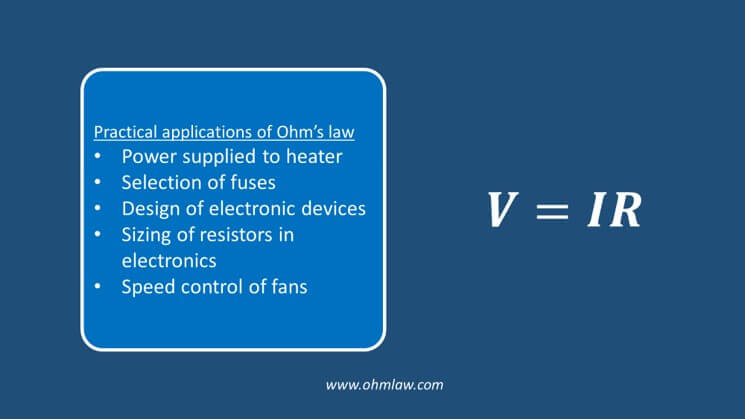5 Practical Applications of Ohm’s Law in Daily Life
Ohm’s Law is a fundamental law of Electrical Engineering. It has a large number of practical applications in almost all electrical circuits and electronic components. Here is a list of 5 Practical Applications of Ohm’s Law in our daily life that we usually come across in our real life.
Power Supplied to Electrical Heater
The electrical heater is a commonly used appliance in winters. Provided with the resistance of heater coil and applied voltage, We can calculate the power supplied to this heater. Let’s assume that resistance of heater coil is 5 ohm and input voltages are 120V. We can use the formula from Ohmic Wheel: P = V2/R to find the power, P = 1202/5 ohm = 2880 watt. This power can then be multiplied with time to calculate the electricity bill at our premises.
Selection of Fuses
Fuses and circuit breakers are the protection components which connect in series with the electronic devices. Fuses/CB’s are rated in Amperes. The current rating of the fuse is calculated by Using the Ohm’s Law. Here are the two cases where you can utilize Ohm’s law for the selection of fuses.
Case 1 – When resistance is known
Let’s consider that you are installing four lamps having 5 ohms resistance. The following steps are followed to size the fuse:
- Find the overall resistance of the circuit. Here it is 20 ohms.
- Since the voltage coming at wall outlet is 120 volts. Apply the formula I = V/R to find the resistance. In our case I = 120/20 = 6 A
One can observe how Ohm’s law helps in sizing fuses.
Case 2 – When wattage ratings are know
Let’ consider you are sizing a fuse for 1 kW iron. In the present case, the formula I = P/V is used for sizing the resistor. I = 1 kW / 120 V = 8.33 A.
Design of Electronic Devices
The electronic devices such as laptop and mobile phones require a dc power supply with the specific current rating. Typical mobile phone batteries require 0.7 – 1 A. A resistor is used to control the rate of current flowing through these components. The Ohm’s law is used to calculate the rating of current which should be used in the typical circuit. The example below illustrates this.
Example: A mobile phone requires a current of 0.8 A while providing 5 volts across it. Find the resistance.
Solution: R = V/I = 5/0.8 A = 6.25 Ω
Sizing of Resistors in consumer electronics
The electronic components such as normal power supplies, uninterruptable supplies, iron, kettle, televisions and similar components use a lot of resistors for their control purposes. The wattage sizing of any resistor should be carefully selected for this purpose. The Ohm’s law is used to size the resistors by using the formula P = VI
Speed Control of Conventional Fans
The speed control of conventional fans is achieved by using a potentiometer. A potentiometer is a variable resistance. A circular knob on the component can be rotated to achieve a variable resistance on the output terminals. For any specific value of the input, we can calculate the resistance, current and thus power flowing through Ohm’s Law.
